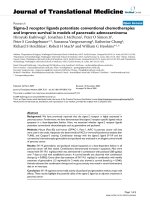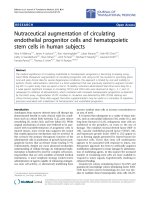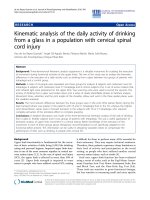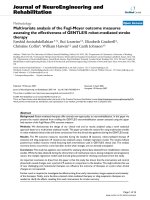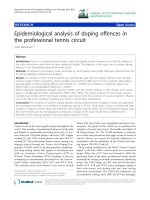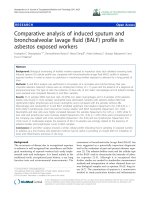Báo cáo hóa học: " Genetic analysis of hantaviruses carried by Myodes and Microtus rodents in Buryatia" doc
Bạn đang xem bản rút gọn của tài liệu. Xem và tải ngay bản đầy đủ của tài liệu tại đây (512.65 KB, 6 trang )
BioMed Central
Page 1 of 6
(page number not for citation purposes)
Virology Journal
Open Access
Research
Genetic analysis of hantaviruses carried by Myodes and Microtus
rodents in Buryatia
Angelina Plyusnina
1
, Juha Laakkonen
2,5
, Jukka Niemimaa
2
, Kirill Nemirov
3
,
Galina Muruyeva
4
, Boshikto Pohodiev
4
, Åke Lundkvist
3
, Antti Vaheri
1
,
Heikki Henttonen
2
, Olli Vapalahti
1
and Alexander Plyusnin*
1,3
Address:
1
Department of Virology, Haartman Institute, University of Helsinki, Finland,
2
Finnish Forest Research Institute, Vantaa, Finland,
3
Swedish Institute for Infectious Disease Control, Stockholm, Sweden,
4
Buryat State Academy of Agriculture, Ulan-Ude, Buryatia, Russian
Federation and
5
Department of Basic Veterinary Medicine, University of Helsinki, Finland
Email: Angelina Plyusnina - ; Juha Laakkonen - ;
Jukka Niemimaa - ; Kirill Nemirov - ; Galina Muruyeva - ;
Boshikto Pohodiev - ; Åke Lundkvist - ; Antti Vaheri - ;
Heikki Henttonen - ; Olli Vapalahti - ;
Alexander Plyusnin* -
* Corresponding author
Abstract
Hantavirus genome sequences were recovered from tissue samples of Myodes rufocanus, Microtus
fortis and Microtus oeconomus captured in the Baikal area of Buryatia, Russian Federation. Genetic
analysis of S- and M-segment sequences of Buryatian hantavirus strains showed that Myodes-
associated strains belong to Hokkaido virus (HOKV) type while Microtus-associated strains belong
to Vladivostok virus (VLAV) type. On phylogenetic trees Buryatian HOKV strains were clustered
together with M. rufocanus- originated strains from Japan, China and Far-East Russia (Primorsky
region). Buryatian Microtus- originated strains shared a common recent ancestor with M. fortis-
originated VLAV strain from Far-East Russia (Vladivostok area). Our data (i) confirm that M.
rufocanus carries a hantavirus which is similar to but distinct from both Puumala virus carried by M.
glareolus and Muju virus associated with M. regulus, (ii) confirm that M. fortis is the natural host for
VLAV, and (iii) suggest M. oeconomus as an alternative host for VLAV.
Background
Hantaviruses (genus Hantavirus, family Bunyaviridae) are
negative-strand RNA viruses with a tripartite genome,
each carried by a specific rodent or insectivore host [1].
Some hantaviruses, e. g. Hantaan and Seoul viruses in
Asia, Puumala (PUUV), Dobrava and Saaremaa viruses in
Europe, Sin Nombre and Andes viruses in the Americas,
are human pathogens while others, e.g. Microtus-associ-
ated hantaviruses of both hemispheres are considered
apathogenic [2,3]. For some hantaviruses, e.g. PUUV-like
Hokkaido virus (HOKV) associated with Myodes rufocanus
or Topografov virus (TOPV) carried by Lemmus sibiricus,
pathogenicity was neither convincingly demonstrated nor
completely ruled out [4,5].
In addition to the abovementioned HOKV, TOPV,
Hantaan, and Seoul viruses, several more hantaviruses
have been found in Asia. These include three well-estab-
lished species: Thottapalayam virus in Suncus murinus [6],
Thailand virus in Bandicuta indica [7], and Khabarovsk
Published: 11 January 2008
Virology Journal 2008, 5:4 doi:10.1186/1743-422X-5-4
Received: 30 November 2007
Accepted: 11 January 2008
This article is available from: />© 2008 Plyusnina et al; licensee BioMed Central Ltd.
This is an Open Access article distributed under the terms of the Creative Commons Attribution License ( />),
which permits unrestricted use, distribution, and reproduction in any medium, provided the original work is properly cited.
Virology Journal 2008, 5:4 />Page 2 of 6
(page number not for citation purposes)
virus (KHAV) in M. fortis [8]. Also several provisional spe-
cies have been described: Da Bie Shan virus in Nivivevnter
confucianus [9], Gou virus in Rattus rattus [9], Vladivostok
virus (VLAV) in M. fortis [10], Amur/Soochong virus in
Apodemus peninsulae [11,12], and Muju virus (MUJV) in
Myodes regulus [13]. Of all Asian hantaviruses, so far only
TOPV was found in Siberia. In this project we attempted
to analyze hantaviruses circulating in Buryatia, the auton-
omy in Russian Federation located between the Lake
Baikal and Mongolia. The biogeographic position of Bur-
yatia is interesting because the taiga corridor zone south
of the Lake Baikal has been important for the exchange of
eastern and western elements of the palearctic fauna.
Methods
Screening of rodent samples
Rodents were trapped in August 2005 in five localities in
Buryatia, Russian Federation. Samples of 504 small mam-
mals were collected, including samples from lung, kidney
and spleen (of most animals) in RNA Later [Ambion] and
in Laemmli sample buffer, and in addition a blood sam-
ple dried on filter paper. The blood samples were
extracted from the filter paper to PBS and were screened
by immunofluorescence assay (IFA) for the presence of
antibodies to hantaviruses (Puumala and Dobrava virus
antigens) (the details of trapping and IFA-screening will
be published elsewhere). Ab-positive rodents were
checked for the presence of hantaviral N-antigen (N-Ag)
using immunoblotting of the lung tissue samples as
described earlier [14,15].
RNA isolation, reverse transcription (RT)-polymerase
chain reaction (PCR) and sequencing
RNA was purified from N-Ag-positive lung tissue samples
with the TriPure reagent (Boehringer Mannheim), accord-
ing to the manufacturer's instructions. RNA was then sub-
jected to the RT-PCR to recover: (i) complete or partial
(coding region) S segment sequences, and (ii) partial (nt
2766-3007) M segment sequences (sequences of primers
and other experimental details are available upon
request). PCR amplicons have been gel-purified with
QIAquick Gel Extraction-kit (QIAGEN) and sequenced
either directly or after cloning into pGEM-T vector
(Promega) using ABI PRISM™ Dye Terminator or ABI
PRISM™ M13F and M13R Dye Primer sequencing kits
(PerkinElmer/ABI, NJ), respectively. HOKV genome
sequences described in this paper have been deposited to
the GenBank sequences database under accession num-
bers AM930972
, AM930975, and AM930976. VLAV
genome sequences described in this paper have been
deposited to the GenBank sequences database under
accession numbers AM930973
, AM930974, AM930977,
AM930978
, and AM930979.
Phylogenetic analysis
To infer phylogenies, the PHYLIP program package [16]
was used. Hantavirus sequences used for comparison were
recovered from the GenBank. 500 bootstrap replicates
generated for complete coding sequences of the S seg-
ment, as well as partial sequences of the M segment (Seq-
boot program) were submitted to the distance matrice
algorithm (Dnadist). Distance matrices were analyzed
with the Fitch-Margoliash tree-fitting algorithm (Fitch) or
with Neighbor-joining algorithm (Neighbor) using the
ML model for nucleotide substitutions; the bootstrap sup-
port values were calculated with the Consense program.
The nucleotide sequence data were also analyzed using
the Tree-Puzzle program (maximum likelihood) [17] with
the HKY model for nucleotide substitutions and 10 000
puzzling steps.
Results
Screening of rodent samples for the presence of hantaviral
markers
Rodents were first screened by IFA for the presence of anti-
hantaviral antibodies. Altogether eight Ab-positive
rodents were selected; these were further checked for the
presence of hantaviral N-Ag. Five animals were found pos-
itive, namely two Myodes rufocanus, #767 and #791, cap-
tured near Muhorshibir town, one Microtus oeconomus,
#483 captured near Barguzin river and two Microtus fortis,
#500 and #503, trapped in the vicinity of Nesterikha vil-
lage. All five N-Ag-positive rodents were analyzed by RT-
PCR with hantavirus-specific primers and all five were
found positive for hantaviral RNA. Hantaviral S and M
segment sequences were recovered from these five
rodents. Complete S segment sequences were recovered
from M. rufocanus #767, M. oeconomus #483, and M. fortis
#503. Partial S segment sequences were recovered from M.
rufocanus #791 (almost complete coding region) and M.
fortis #500 (complete coding region). These partial
sequences appeared identical to the corresponding parts
of the S-sequences recovered from M. rufocanus #767 and
M. fortis #503, respectively. Partial M segment sequences
were recovered for all five animals: nt 2766-3007 for
Microtus, and nt 2702-3007 for Myodes (the numeration is
given for PUUV sequence).
As expected, S- and/or M-sequences from M. rufocanus
showed the closest similarity to the previously described
M. rufocanus- originated sequences from Japan
(Hokkaido), China (Fusong) and Far-East Russia (Primor-
sky region). The name "Hokkaido virus (HOKV)" has
been suggested for the Myodes (erlier called, Clethrionomys)
rufocanus- associated hantavirus and, following this line,
we designated Buryatian wild-type (wt) strains as HOK/
Muhorshibir/Mr767/2005 and HOK/Muhorshibir/
Mr791/2005, or Muhorshibir767 and Muhorshibir791,
for short.
Virology Journal 2008, 5:4 />Page 3 of 6
(page number not for citation purposes)
The S-sequences from Buryatian M. fortis showed the clos-
est similarity to M. fortis-originated sequence recovered
from Vladivostok area, Far-East Russia [10] thus providing
additional evidence that this rodent species can harbor
VLAV. We designated these hantavirus strains VLA/Nes-
terikha/Mf503/2005, and VLA/Nesterikha/Mf500/2005
or Nesterikha503 and Nesterikha500, for short. To our
surprise, the S-sequence recovered from M. oeconomus,
captured near river Barguzin, was very close to the S-
sequence of Nesterikha503 strain. To rule out possible
mistakes in species identification, mtDNA from rodent
#483 was analyzed and its initial identification as M.
oeconomus confirmed. Since hantavirus genome sequence
recovered from M. oeconomus belonged to VLAV genotype
the corresponding wt hantavirus strain was designated as
VLA/Barguzin/Mo483/2005, or Barguzin483, for short.
Genetic analysis of Buryatian HOKV strains
As mentioned above, the S segment sequence of
Muhorshibir767 strain appeared most closely related to
the corresponding sequences of other HOKV strains. For
coding regions the sequence identity was 84–86% (3'-
noncoding regions could not be aligned unequivocally).
On the phylogenetic tree calculated for the S segment cod-
ing region (Fig. 1), strain Muhorshibir767 was placed
within the well supported clade formed by three hantavi-
rus species associated with Myodes voles: PUUV, HOKV,
and MUJV. Within this clade, PUUV and HOKV shared a
more ancient common ancestor and the pair appeared as
sister taxa to MUJV. Notably, the deduced amino acid (aa)
sequences of the N protein of PUUV, HOKV, and MUJV
were of the same length (433 aa residues), a clear sign of
their close genetic ties and shared evolution. Furthermore,
the N protein sequence of Muhorshibir767 strain not only
showed the highest identity to the corresponding
sequences of HOKV strains from Hokkaido and Fusong
(97.5% and 96.5%, respectively) but also carried a specific
aa signature of HOKV: Val/Ile68, Ile262. In addition, all
HOKV strains shared seven signature aa residues with
PUUV: Asp6, Ile134, Val251, Ser305, Ala313, Ile324, and
Gly/Ser412, but only four with MUJV: Lys5, Arg26,
Lys258, and Pro283. On the S-tree (Fig. 1), HOKV strains
formed three genetic lineages represented, respectively, by
strains from Japan (strains Kamiiso and Tobetsu), China
(Fusong strains), and Buryatia (strain Muhorshibir767). It
should be noted that, while PUUV strains (the ones
shown on the Fig. 1 belonged to six genetic lineages)
formed a distinct, well-supported group, the monophyly
of HOKV strains did not receive a substantial bootstrap
support. Hopefully, when more HOKV sequences become
available the phylogenetic resolution would improve.
Similarly to the S segment sequences, the M-sequences
recovered from Buryatian M. rufocanus were most closely
related to the corresponding sequences of other HOKV
strains: the ones from China (Fusong) [sequences availa-
ble from GenBank] and also Far-East Russia (Primorsky
Phylogenetic tree (Fitch-Margoliash) of hantaviruses based on the complete coding region of the S segmentFigure 1
Phylogenetic tree (Fitch-Margoliash) of hantaviruses based on
the complete coding region of the S segment. Only bootstrap
support values greater than 70% are shown. HTNV, Hantaan
virus, strain 76–118; DOBV, Dobrava virus (strain Slovenia);
SAAV, Saaremaa virus, strain Saaremaa; SEOV, Seoul virus
strain (R22); THAI, Thailand virus strain Thailand/Bi50);
ANDV, Andes virus (strain Chile9717869); LANV, Laguna
Negra virus (strain 510B); RIOMV, Rio Mamore virus (strain
OM556); SNV, Sin Nombre virus (strain NMH10); NYV,
New York virus (strain New York-1); MGLV, Monongahela
virus (strain Monongahela1); RIOSV, Rio Segundo virus
(strain RMx-Costa-1); ELMCV, El Moro Canyon virus (strain
RM97); MULV, Muleshoe virus (strain SH-Tx-339); BCCV,
Black Creek Canal virus; KHAV, Khabarovsk virus (strain
MF43); TOPV, Topografov virus (strain TopografovLs136);
VLAV, Vladivostok virus; PUUV, Puumala virus; HOKV,
Hokkaido virus; MUJV, Muju virus; TULV, Tula virus (strain
Moravia02); ISLAV, Isla Vista virus (strain MC-SB-47); PHV,
Prospect Hill virus (strain PH1); BLLV, Blood Land Lake virus
(strain Mo46).
Virology Journal 2008, 5:4 />Page 4 of 6
(page number not for citation purposes)
region) [18]. The M segment sequences of Japanese strains
were not determined yet and, consequently, the Japanese
genetic lineage was not presented on the phylogenetic tree
(Fig. 2). Within HOKV group, Chinese and Russian strains
showed geographical clustering and formed a distinct
genetic lineage. Another lineage was formed by two Bury-
atian strains. The monophyly of all HOKV strains was sup-
ported reasonably well (64%). Again, all Myodes-
originated sequences showed the host-dependent cluster-
ing of PUUV, HOKV and MUJV genetic variants, in good
agreement with the idea of co-evolution of hantaviruses
with their natural carriers [19-21].
Genetic analysis of Buryatian VLAV strains
The S segment sequences of two Nesterikha strains were
identical; their partial M-sequences differed by one silent
substitution only (sequence identity 99.6%). Complete S-
sequences of strains Nesterikha503 and Barguzin483 were
very close to each other: only nine nucleotide substitu-
tions were found in the coding region (sequence identity
99.3%) and only seven mutations, six substitutions and
one deletion, in the 3'-noncoding region that, in this case,
could be easily aligned. Seven of nine nucleotide substitu-
tions found in the coding region were silent. Two muta-
tions caused homologous aa substitutions in the deduced
sequence of the N protein: Lys96->Arg and Ile326->Val.
Partial M segment sequences of these two strains differed
by three silent substitutions (sequence identity 99.2%).
Two closely related S segment sequences of Buryatian
VLAV strains showed the highest level of sequence identity
to the prototype wt strain from Vladivostok (Far-East Rus-
sia): 87.3–87.4%. The deduced aa sequences of the N pro-
tein of two Buryatian VLAV strain were 95.5% identical to
the corresponding sequence of Vladivostok strain. The N-
sequence identities with closely related KHAV and TOPV
were substantially lower: 91.0% and 90.3%, respectively.
On the phylogenetic tree constructed for the S segment
coding region (Fig. 1), two Buryatian VLAV strains clus-
tered in the closest proximity to each other and shared the
most recent common ancestor with the Vladivostok
strain. This trio, in turn, shared a more ancient common
ancestor with KHAV and TOPV. All the branches within
this group were well supported (87% to 100%). Phyloge-
netic trees calculated for partial M segment sequences
showed a similar branching pattern (Fig. 3). All three
VLAV strains from Buryatia clustered together and formed
a monophyletic group with KHAV and TOPV. However,
the bootstrap support values were, again, rather low, most
Phylogenetic tree (Fitch-Margoliash) of Microtus-associated hantaviruses based on partial M segment sequence (nt 2766-3007)Figure 3
Phylogenetic tree (Fitch-Margoliash) of Microtus-associated
hantaviruses based on partial M segment sequence (nt 2766-
3007). For abbreviations, see Fig. 1.
Phylogenetic tree (Fitch-Margoliash) of Myodes-associated hantaviruses based on partial M segment sequence (nt 2702-3007)Figure 2
Phylogenetic tree (Fitch-Margoliash) of Myodes-associated
hantaviruses based on partial M segment sequence (nt 2702-
3007). For abbreviations, see Fig. 1.
Virology Journal 2008, 5:4 />Page 5 of 6
(page number not for citation purposes)
probably due to the very small number (and, perhaps,
also the low genetic diversity) of the sequences available
for this analysis.
Discussion
There are no earlier data on hantaviruses in Buryatia. The
taiga region south of Lake Baikal has acted as a corridor for
the palearctic fauna and Buryatian rodents were therefore
of special interest in the study of hantavirus evolution in
Eurasia. Myodes rufocanus is found throughout the palearc-
tic taiga, and Microtus fortis is at the northwest corner of its
distribution range in Buryatia. Samples of both species
were found positive in our immunoblotting assay; this
suggested a possible involvement of HOKV and KHAV or
VLAV. Earlier, HOKV genome sequences were recovered
from M. rufocanus captured in Japan, Far-East Russia and
China [10,18]. M. fortis was known as the natural host for
KHAV [8]. Our earlier analysis of KHAV and TOPV sug-
gested that a host-switch had occurred in the evolution of
these hantaviruses [5].
There was also a report describing the recovery of partial
hantaviral S segment sequence of from M. fortis captured
near Vladivostok [10]. In our experiments, RT-PCR fol-
lowed by sequencing confirmed the presence of HOKV
and VLAV in M. rufocanus and M. fortis, respectively. These
data support the notion on M. fortis as a natural host for
VLAV. Furthermore, our findings of VLAV sequences in M.
oeconomus suggest that this rodent species could carry
VLAV as well. Notably, both vole species belong to the
same subgenus Alexandromys in the genus Microtus, i.e.
genetically they are closely related to each other [22]. Of
course, spillover of VLAV from its real host (whatever it is)
to other sympatric rodent species, cannot be excluded and
therefore further investigation of this issue is needed.
Phylogenetic analysis of newly recovered Buryatian hanta-
virus sequences was complicated by limited datasets avail-
able for HOKV and especially VLAV genetic variants. This,
in our opinion, was the very reason for the lower than
desired resolution (seen as <70% bootstrap support val-
ues for a number of branching points). Our previous expe-
rience tells that, at least in some cases, an addition of one-
two "critical" sequences to the dataset could remarkably
improve the phylogenetic resolution [23,24]. Some
improvement could also be achieved by the recovery of
longer M segment sequences directly from rodent tissue
samples. So far, this presented a real problem for our Bur-
yatian collection. Isolation of HOKV and VLAV in cell cul-
ture would, undoubtedly, speed the progress in this
direction. Despite these drawbacks, the general phylogeny
of HOKV genetic variants looked logical and supportive to
the hypothesis of hantavirus-host co-evolution (Fig. 1 and
Fig. 2).
Our finding of VLAV sequences in M. oeconomus was a bit
surprising and thus added a new twist to the already quite
intriguing relationships between TOPV, KHAV, and VLAV.
KHAV and VLAV, both carried by Microtus voles, do not
cluster on the phylogenetic trees with other hantaviruses
carried by Microtus (TULV, PHV, ISLAV, and BLLV) but
instead appeared monophyletic with TOPV and the
KHAV-VLAV-TOPV trio forms a sister taxon to the Myodes-
carried hantaviruses: PUUV, HOKV, and MUJV (Fig. 1).
This clustering is in apparent disagreement with strict
hantavirus-host co-evolution and would suggest host-
switching event(s). One could imagine three possible sce-
narios. The first scenario includes a host-switch of an
ancient hantavirus from Myodes to Lemmus yielding an
ancestor for TOPV, KHAV, and VLAV, followed by two
independent, and separated in time, host-switching
events of a Lemmus-associated virus to Microtus yielding
KHAV and VLAV. The second scenario involves a "jump"
of an ancient hantavirus from Myodes to Microtus followed
by diversification of hosts for KHAV and VLAV and
another "jump" of pre-KHAV from Microtus to Lemmus
yielding TOPV. The third scenario implies that Microtus-
associated hantaviruses are the most ancestral ones
among the group carried by Arvicolinae rodents. According
to this scenario, in a single host-switching event an
ancient Microtus-carried virus gave origin to the ancestor
of all Myodes-carried viruses and later pre-KHAV virus
"jumped" from Microtus to Lemmus, producing TOPV.
Future studies, incuding analysis of larger sets of TOPV,
KHAV and VLAV variants, preferably originated from a
wider geographical area and showing substantial genetic
diversity, would be needed to evaluate these hypotheses.
Conclusion
In this paper, for the first time, we describe HOKV and
VLAV strains found in Buryatia, Russian Federation.
Although no human cases have been so far attributed to
either of these two hantaviruses, further epidemiological
studies are needed to estimate a seroprevalence to HOKV
and VLAV (as well as other hantaviruses, such as Amur/
Soochong virus carried by Apodemus peninsulae) in Burya-
tian population and to evaluate potential threats to
human health which might be imposed by these hantavi-
ruses.
Competing interests
The author(s) declare that they have no competing inter-
ests.
Authors' contributions
AngP participated in the screening of rodent samples, per-
formed RT-PCR and sequencing, participated in the
genetic analysis and contributed to writing of the manu-
script. JL, JN and BP participated in fieldwork and in
Publish with BioMed Central and every
scientist can read your work free of charge
"BioMed Central will be the most significant development for
disseminating the results of biomedical research in our lifetime."
Sir Paul Nurse, Cancer Research UK
Your research papers will be:
available free of charge to the entire biomedical community
peer reviewed and published immediately upon acceptance
cited in PubMed and archived on PubMed Central
yours — you keep the copyright
Submit your manuscript here:
/>BioMedcentral
Virology Journal 2008, 5:4 />Page 6 of 6
(page number not for citation purposes)
screening of rodent samples. KN performed genetic anal-
ysis of rodents. GM and ÅL participated in the study coor-
dination. AV, HH and OV participated in the study design
and coordination, and in drafting the manuscript, the lat-
ter two also in fieldwork. AP participated in the study
design and coordination, performed (phylo)genetic anal-
yses and contributed to writing of the manuscript. All
authors read and approved the final manuscript.
Acknowledgements
This work was supported by grants from the University of Helsinki, The
Academy of Finland, Sigrid Jusélius foundation (Finland) and EU grant
GOCE-CT-2003-010284 EDEN and the paper is officially catalogued by the
EDEN Steering Committee as EDEN 0076. We thank Ilkka Alitalo for his
support and Stanislav Suhunov for help in collecting the material.
References
1. Nichol ST, Beaty BJ, Elliott RM, Goldbach R, Plyusnin A, Schmaljohn
CS, Tesh RB: Bunyaviridae. In Virus taxonomy. VIIIth report of the
International Committee on Taxonomy of Viruses Edited by: Fauquet CM,
Mayo MA, Maniloff J, Desselberger U, Ball LA. Amsterdam: Elsevier
Academic Press; 2005:695-716.
2. Lundkvist Å, Plyusnin A: Molecular epidemiology of hantavirus
infections. In The Molecular Epidemiology of Human Viruses Edited by:
Leitner T. Kluwer Academic Publishers; 2002:351-384.
3. Vapalahti O, Mustonen J, Lundkvist A, Henttonen H, Plyusnin A,
Vaheri A: Hantavirus infections in Europe. Lancet Infect Dis 2003,
3:653-661.
4. Kariwa H, Yoshimatsu K, Araki K, Chayama K, Kumada H, Ogino M,
Ebihara H, Murphy ME, Mizutani T, Takashima I, Arikawa J: Detec-
tion of hantaviral antibodies among patients with hepatitis of
unknown etiology in Japan. Microbiol and Immunol 2000,
44(5):357-362.
5. Vapalahti O, Lundkvist Å, Fedorov V, Conroy C, Hirvonen S, Ply-
usnina A, Nemirov K, Fredga K, Cook J, Niemimaa J, Kaikusalo A,
Henttonen H, Vaheri A, Plyusnin A: Isolation and characteriza-
tion of a hantavirus from Lemmus sibiricus: evidence for host-
switch during hantavirus evolution. J Virol 1999, 73:5586-5592.
6. Carey DE, Reuben R, Panicker KN, Shope RE, Myers RM: Thotta-
palayam virus: a presumptive arbovirus isolated from a
shrew in India. J Med Res 1971, 59:1758-1760.
7. Elwell MR, Ward GS, Tingpalapong M, Leduc JW: Serologic evi-
dence of Hantaan-like virus in rodents and man in Thailand.
Southeast Asian J Trop Med Public Health 1985, 16:349-354.
8. Hörling J, Chizhikov V, Lundkvist Å, Jonsson M, Ivanov L, Dekonenko
A, Niklasson B, Dzagurova T, Peters CJ, Tkachenko E, Nichol ST:
Khabarovsk virus. A phylogenetically and serologically dis-
tinct hantavirus isolated from Microtus fortis trapped in far-
east Russia. J Gen Virol 1996, 77:687-694.
9. Wang H, Yoshimatsu K, Ebihara H, Ogino M, Araki K, Kariwa H:
Genetic diversity of hantaviruses isolated in China and char-
acterization of novel hantaviruses isolated from Niviventer
confucianus and Rattus rattus. Virology 2000, 278:332-345.
10. Kariwa H, Yoshimatsu K, Sawabe J, Yokota E, Arikawa J, Takashima I,
Fukushima H, Lundkvist A, Shubin FN, Isachkova LM, Slonova RA,
Leonova GN, Hashimoto N: Genetic diversities of hantaviruses
among rodents in Hokkaido, Japan and Far East Russia. Virus
Res 1999, 59:219-228.
11. Yashina L, Mishin V, Zdanovskaya N, Schmaljohn C, Ivanov L: A
newly discovered variant of a hantavirus in Apodemus penin-
sulae, far Eastern Russia. Emerg Inf Dis 2001, 7:912-913.
12. Baek LJ, Kariwa H, Lokugamage K, Yoshimatsu K, Arikawa J,
Takashima I, Kang JI, Moon SS, Chung SY, Kim EJ, Kang HJ, Song KJ,
Klein TA, Yanagihara R, Song JW: Soochong virus: an antigeni-
cally and genetically distinct hantavirus isolated from Apode-
mus peninsulae in Korea. J Med Virol 2006, 78:290-297.
13. Song KJ, Baek LJ, Moon S, Ha SJ, Kim SH, Park KS, Klein TA, Sames
W, Kim HC, Lee JS, Yanagihara R, Song JW: Muju virus, a novel
hantavirus harboured by the arvicolid rodent Myodes regu-
lus in Korea. J Gen Virol 2007, 88:3121-3129.
14. Plyusnin A, Cheng Y, Vapalahti O, Pejcoch M, Unar J, Jelinkova Z, Leh-
väslaiho H, Lundkvist Å, Vaheri A: Genetic variation in Tula
hantaviruses: sequence analysis of the S and M segments of
strains from Central Europe. Virus Res 1995, 39:237-250.
15. Plyusnina A, Ibrahim IN, Winoto I, Porter KR, Gotama IBI, Lundkvist
Å, Vaheri A, Plyusnin A: Identification of Seoul hantavirus in
Rattus norvegicus in Indonesia. Scand J Inf Dis 2004, 36:356-359.
16. Felsenstein J: PHYLIP [Phylogeny Inference Package]. 1993.
3.5c
17. Schmidt HA, Strimmer K, Vingron M, von Haesseler A: TREE-PUZ-
ZLE: maximum likelihood phylogenetic analysis using quar-
tets and parallel computing. Bioinformatics 2002, 18:502-504.
18. Yashina LN, Slonova RA, Oleinik OV, Kuzina II, Kushnareva TV, Kom-
panets GG, Simonov SB, Simonova TL, Netesov SV, Morzunov SP: A
new genetic variant of the PUUV virus from the Maritime
Territory and its natural carrier red-grey vole Clethrionomys
rufocanus. Vopr Virusol 2004, 49:34-37. (in Russian)
19. Plyusnin A, Vapalahti O, Vaheri A: Hantaviruses: genome struc-
ture, expression and evolution. J Gen Virol 1996, 77:2677-2687.
20. Plyusnin A: Genetics of hantaviruses: implications to taxon-
omy. Arch Virol 2002, 147:665-682.
21. Nemirov K, Vaheri A, Plyusnin A: Hantaviruses: co-evolution
with natural hosts. Recent Res Devel Virol 2004, 6:201-228.
22. Wilson DE, Reeders DM: Mammal species of the world. A tax-
onomic and geographic reference. Third edition. The Johns
Hopkins University Press; 2005.
23. Nemirov K, Andersen HK, Henttonen H, Vaheri A, Lundkvist Å, Ply-
usnin A: Saaremaa hantavirus in Denmark. J Clin Virol 2004,
39:254-257.
24. Sironen T, Vaheri A, Plyusnin A: Phylogenetic evidence for the
distinction of Saaremaa and Dobrava hantaviruses. Virol J
2005, 2:90.
